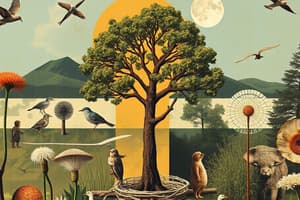Podcast
Questions and Answers
Match each ecological term with its correct definition:
Match each ecological term with its correct definition:
Species = A particular type of organism whose individuals can interbreed and produce fertile offspring. Population = A group of individuals of the same species living in the same area at the same time. Community = A group of populations living and interacting with each other in a common habitat. Ecosystem = A community of interconnected organisms and the physical environment they inhabit.
Match the biome with the characteristics they exhibit:
Match the biome with the characteristics they exhibit:
Tundra = Characterized by low temperatures and short growing seasons. Desert = Characterized by sparse rainfall and extreme temperature fluctuations. Tropical Rainforest = Characterized by high biodiversity and high rainfall. Temperate Forest = Characterized by moderate rainfall and distinct seasons.
Match each environment type with its ecological characteristic:
Match each environment type with its ecological characteristic:
Habitat = The environment where a species normally lives. Biotope = The geographic area where communities live. Ecotone = The transition area between two biomes, typically with high species diversity. Ecological niche = How an organism makes a living, including all its relationships.
Match the following ecological levels to their descriptions:
Match the following ecological levels to their descriptions:
Match each ecological interactions with their potential effects on the individual:
Match each ecological interactions with their potential effects on the individual:
Match each description to the correct type of ecological study:
Match each description to the correct type of ecological study:
Match the ecological processes with their description:
Match the ecological processes with their description:
Match the following processes with thier definitions:
Match the following processes with thier definitions:
Match the key ecosystem components to their role:
Match the key ecosystem components to their role:
Match the environmental challenges with one of their primary ecological consequences:
Match the environmental challenges with one of their primary ecological consequences:
Connect each term with its most associated concept:
Connect each term with its most associated concept:
Match the following concepts with their correct descriptions:
Match the following concepts with their correct descriptions:
Match each of the following organisms to their basic role in an ecosystem:
Match each of the following organisms to their basic role in an ecosystem:
Match each of the ecosystem dynamics with the best definition:
Match each of the ecosystem dynamics with the best definition:
Connect the ecological term with its definition:
Connect the ecological term with its definition:
Match each term with the correct description related to ecological patterns:
Match each term with the correct description related to ecological patterns:
Connect the environmental issues listed below with the type of issue they represent:
Connect the environmental issues listed below with the type of issue they represent:
Associate each of the following conservation strategies with what it aims to accomplish:
Associate each of the following conservation strategies with what it aims to accomplish:
Match the ecological modeling methods with their usefulness:
Match the ecological modeling methods with their usefulness:
Flashcards
Ecology
Ecology
The branch of biology studying the relationships between species, within species, and with their environment.
Species
Species
A particular type of organism whose individuals can interbreed and produce fertile offspring.
Population
Population
A group of individuals of the same species living in the same area at the same time.
Community
Community
Signup and view all the flashcards
Ecosystem
Ecosystem
Signup and view all the flashcards
Biome
Biome
Signup and view all the flashcards
Biosphere
Biosphere
Signup and view all the flashcards
Habitat
Habitat
Signup and view all the flashcards
Biotope
Biotope
Signup and view all the flashcards
Ecotone
Ecotone
Signup and view all the flashcards
Ecological niche
Ecological niche
Signup and view all the flashcards
Study Notes
- Ecology is the study of the relationships between species, within a species, and with their environment.
Ecological Terminology
- Species are a particular type of organism whose individuals can interbreed and produce fertile offspring.
- Population refers to a group of individuals of the same species living in the same area at the same time.
- Community is a group of populations living and interacting with each other in a common habitat.
- Ecosystem is a community of interconnected organisms and the physical (abiotic) environment they inhabit.
- Biome is a collection of ecosystems sharing common climatic conditions, such as tundra, desert, or tropical rainforest.
- Biosphere refers to the part of the Earth inhabited by organisms, from 11 km below sea level to 10 km above.
- Habitat is the environment where a species normally lives; many populations of different species may share the same area.
- Biotope is the geographic area where communities live.
- Ecotone is the transition area between two biomes, characterized by high species diversity.
- Ecological niche describes how an organism makes a living, encompassing all its relationships.
Studying That Suits You
Use AI to generate personalized quizzes and flashcards to suit your learning preferences.




